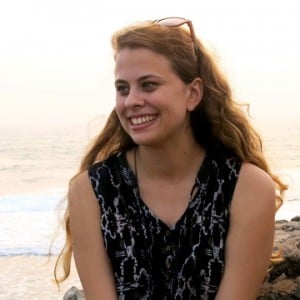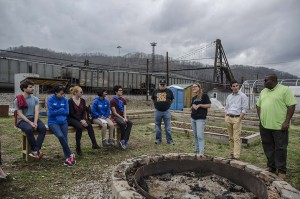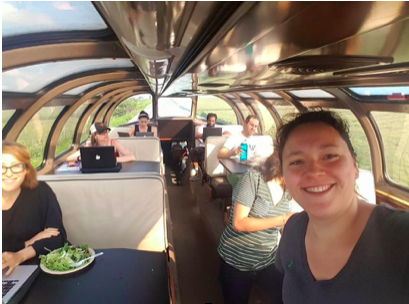
Allison Braden, a Fulbright English Teaching Assistant in Bangladesh 2013-2014, is a Fulbright U.S. Student Program Alumni participant in the Fulbright Amizade 2016 service-learning activity.
I am, frankly, overwhelmed. In the first day and a half of my experience with Amizade in Appalachia, I’ve been forced to confront a swarm of questions that I don’t have answers to and are perhaps unanswerable, but our asking questions without necessarily arriving at conclusions will give shape to the rest of our week.
Today I saw a barber shop called Cuttin’ Up with Belinda. I loved that. I love Americana, and here, it’s everywhere. There are church steeples, American flags, and main streets. There aren’t very many streetlights. My mind jumps from comparison to comparison: Convenience stores selling a little of everything remind me of Bangladesh. The high school football stadium, an island of bright green in a sea of gravel on top of a mined mountain, made me think of Friday Night Lights on TV. The old pickup trucks and main streets remind me of south Georgia and country songs. Despite how different my own community is from the ones I’m getting to visit here and despite West Virginia’s reputation elsewhere in the country, my associations with small town America are almost universally positive. In fact, I have the tendency to romanticize rural communities.


Fulbright Amizade participants start the week-long enrichment activity learning the history of Williamson and WV, and visiting community gardens. Photo by Daniel Alexander/Amizad
To me, they represent values that are fundamental to building mutual understanding: trust in your neighbors, opportunities for one-on-one interaction across difference, knowledge of and compassion for the community as a whole. While I believe these things really are hallmarks of small town American life, I also suspect that in large part, my romanticization of rural America reflects my nostalgia for something that doesn’t exist and never really did. I’ve never lived in a rural community, so I’ve never had to face the downsides of small town life. The crushing desire to get out of a small town and escape is so common. I’ve never experienced that. I’ve always been able to drop in and out when I want to, and that feels important.
I’m looking forward to my time here being a forum for exploration. Such an exploration must begin with an honest assessment of what I don’t know, but also what I do know. I want to learn, but I also want to bring my knowledge to the table. I want to aggressively challenge what I know and remain open both to the possibility of my assumptions being contradicted, but also to the possibility of their being confirmed, remaining cognizant of ways that the program limits my understanding (e.g. only having a week).
The sky was gray today. It drizzled some. The trees remain leafless and the landscape beige as the last week of winter begins. I was struck by the implications of our visiting at this time of year. Williamson’s community garden is still mostly empty, and my preconception of poverty and despair in a post-coal community were exacerbated by the season. As the team at Sustainable Williamson drove us around the community showing us some of the successes that their community initiatives have had — walking trails around the garden, a wheelchair accessible garden plot already planted for the season, a thriving health clinic in the middle of town — I was reminded that the end of winter is also the cusp of spring.
Follow the Fulbright Amizade participants on Twitter and Instagram with #FulbrightAmizade. Check out this Storify where they chronicle their experiences.


No Comments